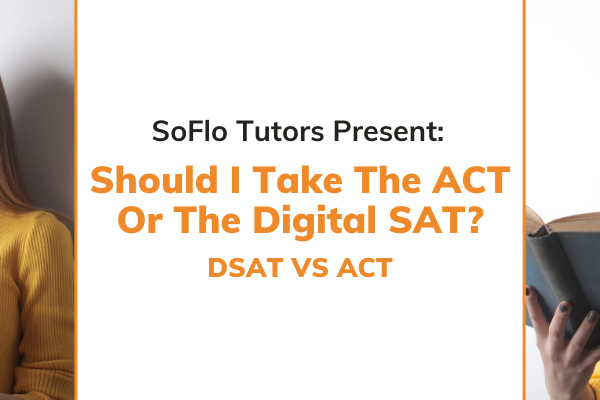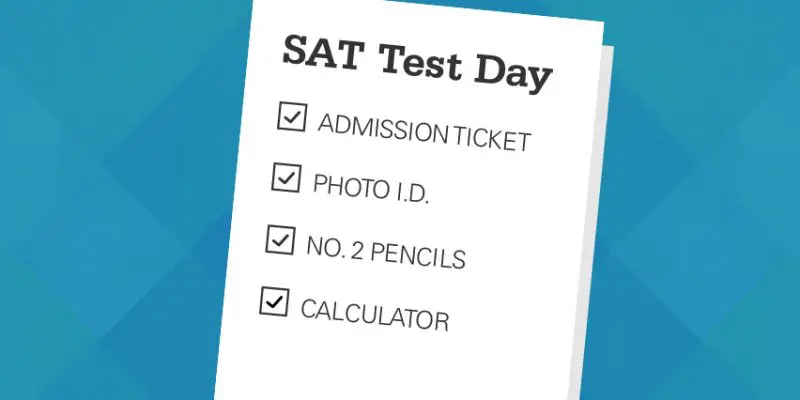
Feeling prepared on test day is crucial to success when taking the SAT or any of the SAT Subject Tests. Having the right calculator, pencil, and especially the right snack can help students feel confident and ready. On the other hand, students want to be sure they don’t bring anything to the exam that will disqualify their score. After hours of studying, make sure your child’s test isn’t invalidated just because they used a mechanical pencil and all of their hard work doesn’t go to waste. Use this SAT checklist to know what your child needs to bring for their SAT Test.
The Essentials: Items Necessary to Succeed on the SAT
Students must bring these items to their SAT testing center. These essentials are the absolute minimum students need to succeed.
Printed Admissions Ticket
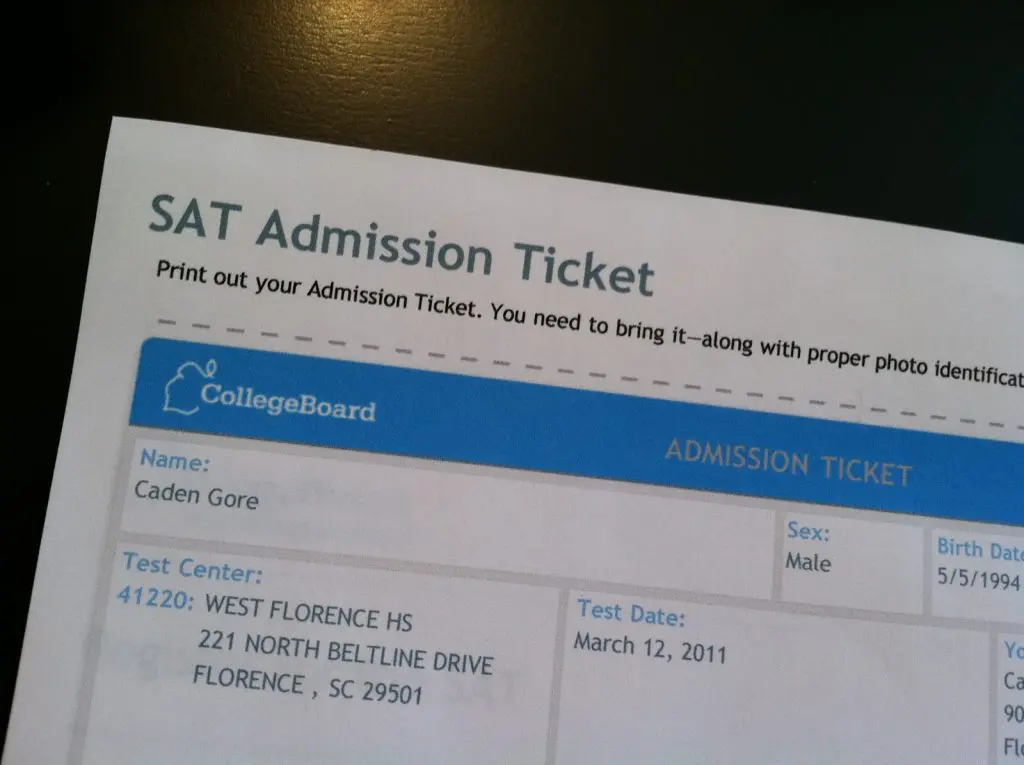
Students must sign into their College Board account to print their admissions ticket. We recommend bringing two copies for extra security and ease of mind in case something unexpected happens. The Admissions Ticket is the students’ proof they are registered to take the SAT and has helpful information about the testing center and any accommodations they may need. Students will not be allowed into the testing center unless they have their Admissions Ticket, so this item is absolutely crucial.
After students finish registering for the exam, a screen will appear with their SAT Admissions Ticket. Upon verifying the ticket information, students must print the ticket. The tickets are accessible anytime through their College Board account if the student needs to print one at a later time or print a duplicate.
Accepted Photo of School ID
According to College Board, ID documents must meet all of these requirements:
Be a valid and unexpired, government-issued or school-issued ID. Note that school IDs from the prior school year are valid through December of the current calendar year (school IDs from 2019-2020 are valid through December 31st, 2020).
Be the original document, not a photocopy or picture/file on an electronic device.
List the student’s full legal name as it appears on the Admission Ticket, including order of the names.
Demonstrate a recent picture that matches both the student’s appearance on test day and the photo on the student’s Admission Ticket.
Be in good condition with legible English-language text and a clear photograph of the student taking the test.
The SAT board tightened up Photo ID measures after a string of cheating scandals around 2012, when college-aged students created fake identification cards to take the SAT for younger kids in exchange for payment. Due to the high level of security the SAT employs to verify identification now, students should double check that they have a proper and real ID before leaving to take the SAT to avoid any complications that may arise.
Calculator
Students should make sure their calculators are permitted for the SAT; calculators with Internet access, Bluetooth, and other cellular functions are not allowed for test taking. Devices with cameras or audio/visual recording features are also strictly prohibited, so students will not be able to use their phone calculators if they forget to bring a standard calculator. Students should make sure they charge and pack their calculators the night before. To double-check if a specific type of calculator is allowed on the SAT, I recommend a quick Google search.
A few acceptable calculators include:
- TI 30x
- TI-84 Plus
- FX-6000 Series (Casio)
For a calculator that won’t break the bank, the TI 30x is a good option. The calculator contains a cursor feature to insert or delete numbers as needed. It can also handle all of the functions that the SAT tests. For students looking for a top-of-the-line calculator, the TI-84 Plus has all the graphing capabilities a student could ask for.
#2 Pencils
Students should bring at least two #2 pencils to the SAT. While there are a variety of pencils available in stores, not all are created equal. Students should bring pencils they have already used and liked to avoid any unwelcome surprises on test day like bad erasers or easily breakable pencils.
Students should also come to the testing center with their pencils fully sharpened. Usually, proctors or the testing room will have a pencil sharpener, but for time and stress purposes it is best to come prepared. For example, if the proctor needs to get started by a certain time, he or she can rush students who need to finish sharpening their pencils. Most importantly, students should remember to not bring mechanical pencils.
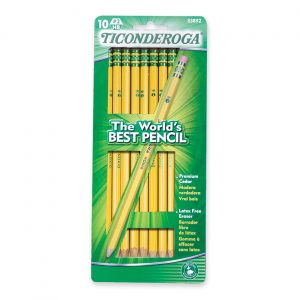
At SoFlo we are partial to Ticonderoga pencils. The erasers are better, and the sharp smaller pencil points are harder to break.
Snacks and Water
Students can minimize distractions like hunger or thirst if they bring along snacks and water to enjoy during the breaks. Again, since the SAT is a very long 4 hour test, it can also add a new change of peace to the otherwise dull experience if the student can eat something they enjoy.
Snacks and water are not absolutely required to take the SAT, but can be a smart choice given how long the test takes.
Students should bring snacks that are filled with protein to keep them satiated and full of energy. Snacks like nuts or fruit/nut/protein bars are a safe bet for students who want an extra boost during testing but want to avoid a sugar crash.
An important note for students who have never tried coffee before: the day of the SAT is not the time to start! Too much coffee can make nerves much worse, which can interfere with SAT performance. Regular coffee drinkers should also make the effort to limit their coffee consumption in order to avoid feeling jittery before taking the SAT.
Suggested but not Required: Recommended Items to Bring to SAT Test Day
We encourage students to do everything possible to be successful. These items will give test takers the extra edge by making them more comfortable or productive.
Bag, Backpack, or Purse
Since there is a checklist of items to bring to the SAT, it’s best for students to prepare and keep all their items organized in a bag, backpack, or purse. Bringing something to keep everything in one place is also helpful because students won’t need to worry about carrying too much or leaving something at home by accident.
I recommend reducing morning-of stress on SAT test day by packing everything necessary the night before.
Jacket or Sweater
Students normally score better on practice tests taken from the comfort of their own homes than they do on the real SAT tests because they aren’t used to their environments.
Most SAT testing rooms are known for their cold temperatures. Since it can get chilly, students might not be able to perform to the best of their ability if the temperature is causing them discomfort, so it’s a good idea to bring a jacket or sweater to wear if the room is frigid like an igloo.
Digital Watch
Not all testing rooms will be the same, and depending on seating arrangements, checking the clock might not be as easy as it should be. To avoid craning my neck to see the clock on the SAT, I found it much easier to rely on a watch. In a worst-case scenario, the clock in the testing room might be inaccurate, so students should consider bringing another source to make sure they are staying on track with time.
Especially for those who struggle with timing issues when taking the SAT, bringing a watch could reduce stress and allow students to keep track of their progress with ease. For extra speed, students should consider digital instead of analog watches. Casio is a reliable and relatively cheap option.
Earplugs
Earplugs are technically not allowed but will not lead to an invalidation of test scores. Most likely, proctors will ask a student not to use them if they notice. Electronic earplugs or bulky headphones will probably not fly, but students would probably be able to get away with disposable earplugs. If students feel strongly about their need for absolute quiet during the exam, earplugs are an option to consider.
However, students should note that earplugs might get in the way of hearing when a proctor calls a time warning, especially if it’s an important one like the 5-minute warning. Additionally, in my personal experience, testing rooms are extremely quiet: everyone is busy focusing on their own exam and most likely will not make any disturbances. The proctor will mediate any issues that arise and remind students to keep quiet if any disruptions occur.
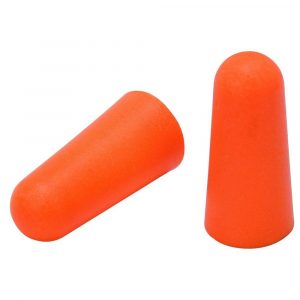
Tissues
A runny nose can ruin a test day experience. Bringing a pack of Kleenex to the exam room can ensure that a little sniffle won’t hold a student back from test day success.
Pencil Sharpener
Having a hand-held sharpener can solve the stress of a pencil breaking in the middle of the exam so the student can simply resharpen their pencil and continue working. Pencil sharpeners are sometimes available within the testing room, but to avoid wasting time while waiting for the proctor to approve the student’s request to use it, bringing a small personal sharpener can benefit the student.
Never Bring These Banned Items to the SAT
These banned items can lead to an invalid test score. Students who study for months to prepare for the SAT should not risk having their SAT scores cancelled because of a small preventable mistake.
Mechanical Pencils
Students should never bring or use mechanical pencils on the SAT.
Best case scenario, the proctor will notice if anyone brought a mechanical pencil and ask those students to stop and use a #2 pencil. However, if a student decides to use a mechanical pencil on the exam, their test can be invalidated and all of the hard work and preparation that went into it will be for nothing. If a student finds themself with only a mechanical pencil when in the testing room, They should ask the proctor if there are any extra #2 pencils and avoid mechanical pencils at all costs.
Highlighters
Unfortunately, the SAT does not allow highlighters on the exam. Personally, I find that underlining important sentences or information with my #2 pencil makes it easier to focus and remember details while taking the test. It can function in the same way as a highlighter, just without that pop of color.
Smart Watch/Apple Watch
The SAT absolutely prohibits any devices that can be used to record, transmit, receive, or play back audio, photographic, text, or video content. Students should leave their smart watches or Apple watches at home if they have one, but regular analog/digital watches are fine to bring to the testing center.
Cameras
Hopefully, this one is pretty clear! No devices that can record or capture content are allowed when students take the SAT in order to minimize cheating. If a proctor sees a camera in a student’s possession, it will raise suspicion or cause serious issues — it is best to leave cameras at home.
Standalone timers or alarms
The SAT strictly enforces quiet during the test out of respect for all test takers. Bringing timers and alarms to help keep track of time is not allowed because of their potential to distract everyone in the testing room. A better alternative is to bring a simple and silent analog/digital watch to keep an eye on the clock.
Protractors, Compasses, or Rulers
Students are not allowed to bring any outside tools to help them during their SAT test, including protractors, compasses, or rulers. The SAT will never include questions that require these extra tools to find the solution. One thing to keep in mind is that the images on the SAT math sections are usually not to scale, so tools like rulers would not help anyway.
Colored Pens or Pencils
Colored pens and pencils are not allowed on the SAT. Students should especially note that writing in the answer booklet with colored pens or pencils will result in test invalidation! Only #2 pencils should be used on the answer sheets.
Dictionaries, Books, Pamphlets, Scratch Paper
The SAT does not allow students to bring any dictionaries, books, pamphlets, or scratch paper. Students should note that bringing a dictionary could result in invalidation, especially because the SAT reading and writing sections often test vocabulary. A general tip instead to prepare for the vocabulary definition questions would be to read as much as possible before the day of the SAT — this will improve overall reading comprehension, and reading new words in context will help naturally improve vocabulary.
Students will not need to bring any books because breaks will be short and reserved for snack breaks and general rest with no time for reading. The SAT will provide plenty of space for work, so students should not worry about needing additional scratch paper when taking the test.
College Board’s Statement About Use of Prohibited Devices:
“If your device makes noise or you are seen using it at any time, including during breaks, you may be dismissed immediately, your scores can be canceled, and the device may be confiscated and its contents inspected. The College Board is not responsible for loss or damage to personal items, including electronic devices, while you are in the test center.”
Should I Bring My Phone to the SAT?
Students should bring their phones. Otherwise, how can they tell their SoFlo Tutor that they crushed the exam as they walk out of the testing center? Students should also bring their phones so they coordinate with their parents to pick them up from the testing center if needed.
While students should have their phones with them when they go to take the SAT, it must be turned off during the test, even during breaks. Any electronic devices (including cell phones) have to be off, so students should make sure all of their items are completely shut down. Test centers are serious about security and quiet, so prohibited devices like cell phones, tablets, and MP3 players, have to be turned off and put under the desk. Students should also be sure to turn off any watch alarms that may go off during the test.
If students are caught with their phone on during the test, it could lead to cancellation of their scores and further disciplinary infractions, so test-takers should avoid the stress and just make sure every electronic connected to the Internet is off when the proctor reminds them to do so.
Other Test Day Tips for SAT Success
- Gather all necessary materials beforehand
- Charge calculator if needed
- Print two copies of Admission Ticket
- Get a good night’s sleep
- Eat a good breakfast
About The Author

Emily Moon is an expert SAT & ACT tutor at SoFlo Tutors. Emily studies Communications and Consumer Psychology at the University of Pennsylvania. She was a National Merit Scholar in high school, scored a 1580 on the SAT, and scored an 800 on the SAT Literature Subject Test. She keeps busy writing music articles for 34th Street Magazine or writing social media copy for the Institute of Contemporary Art. In her free time, she enjoys listening to music, painting, or playing the guitar.

